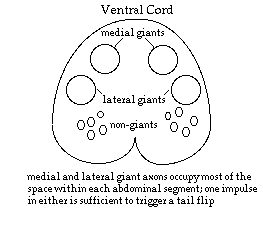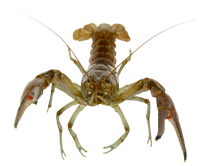Behavioral Neuroscience, lecture on Crayfish and its behavior
Escape - Crayfish
III. Crayfish Neuroanatomy
A. Nervous system consists of a chain of ganglia
1. similar to the spinal cord it is medially located
2. in contrast to the spinal cord it is ventrally located
a. except the brain
3. Chain of 13 ganglia (neural cell body groups)
a. connected by projection axons
b. in a linear chain
4. Chain begins rostrally (anterior) with the brain
a. brain is dorsal
i. serves rostral sensory organs
ii. eyes, antannae
b. 5 thoracic ganglia
i. serve legs
ii. ganglion 2 serves gullet (food tube)
iii. ganglion 6 serves sternal artery
c. 6 abdominal ganglia
i. serves swimmerets
ii. serves the tail
d. therefore, each ganglion serves local physiology and anatomy
B. All of the nervous system is contained in this chain
1. unlike vertebrates with Brain and Spinal cord = Central Nervous System (CNS)
a. and Peripheral Nervous System (PNS)
C. Inputs and Outputs
1. Defined by postion on the ganglion
a. 1st root is the largest, lateral root
i. root contains sensory dendrite inputs
1) to cell bodies in the ganglion
ii. and motor axon outputs
1) from cell bodies in the ganglion
2) cell bodies = soma, perikarya
b. 2nd root is posterior to 1st root
c. 3rd roots are posterior
i. along the connective
1) between ganglia
D. Identified Neurons
1. Each and every ganglion includes a very similar set of neuronal soma
a. All of the neurons are known
b. All of the functions of each neuron can be known
i. the function of many neurons in each ganglion are known
2. 3 important neuron types
a. Medial Giant Neurons (MG)  i. MG = pair of neurons
ii. dorsally located
1) in brain, thoracic and abdominal ganglia
iii. excited by an attack to front of the animal
iv. induce quick curling of abdomen and throws animal backward
v. activated by rostral stimuli and cause all abdominal segments to bend
b. Lateral Giant Neurons (LG)
i. also a pair of neurons
ii. ventral and lateral to MG
1) in abdominal ganglia
2) all LG are electrically interactive
iii. LG excited by strong, sudden stimulus to tail
iv. Cause only bending in rostral abdominal segments
v. Trigger sudden sharp flip of abdomen to throw crayfish upward
1) hind end rotates forward away from stimulus
c. non-Giant Neurons (NG)
i. many neurons
ii. ventral to LG
iii. Excited by more gradual stimuli
iv. trigger directed tail flip escape
E. Coordination of these 3 systems results in adaptive responses to real and potential threat
i. MG = pair of neurons
ii. dorsally located
1) in brain, thoracic and abdominal ganglia
iii. excited by an attack to front of the animal
iv. induce quick curling of abdomen and throws animal backward
v. activated by rostral stimuli and cause all abdominal segments to bend
b. Lateral Giant Neurons (LG)
i. also a pair of neurons
ii. ventral and lateral to MG
1) in abdominal ganglia
2) all LG are electrically interactive
iii. LG excited by strong, sudden stimulus to tail
iv. Cause only bending in rostral abdominal segments
v. Trigger sudden sharp flip of abdomen to throw crayfish upward
1) hind end rotates forward away from stimulus
c. non-Giant Neurons (NG)
i. many neurons
ii. ventral to LG
iii. Excited by more gradual stimuli
iv. trigger directed tail flip escape
E. Coordination of these 3 systems results in adaptive responses to real and potential threat

 i. MG = pair of neurons
ii. dorsally located
1) in brain, thoracic and abdominal ganglia
iii. excited by an attack to front of the animal
iv. induce quick curling of abdomen and throws animal backward
v. activated by rostral stimuli and cause all abdominal segments to bend
b. Lateral Giant Neurons (LG)
i. also a pair of neurons
ii. ventral and lateral to MG
1) in abdominal ganglia
2) all LG are electrically interactive
iii. LG excited by strong, sudden stimulus to tail
iv. Cause only bending in rostral abdominal segments
v. Trigger sudden sharp flip of abdomen to throw crayfish upward
1) hind end rotates forward away from stimulus
c. non-Giant Neurons (NG)
i. many neurons
ii. ventral to LG
iii. Excited by more gradual stimuli
iv. trigger directed tail flip escape
E. Coordination of these 3 systems results in adaptive responses to real and potential threat
i. MG = pair of neurons
ii. dorsally located
1) in brain, thoracic and abdominal ganglia
iii. excited by an attack to front of the animal
iv. induce quick curling of abdomen and throws animal backward
v. activated by rostral stimuli and cause all abdominal segments to bend
b. Lateral Giant Neurons (LG)
i. also a pair of neurons
ii. ventral and lateral to MG
1) in abdominal ganglia
2) all LG are electrically interactive
iii. LG excited by strong, sudden stimulus to tail
iv. Cause only bending in rostral abdominal segments
v. Trigger sudden sharp flip of abdomen to throw crayfish upward
1) hind end rotates forward away from stimulus
c. non-Giant Neurons (NG)
i. many neurons
ii. ventral to LG
iii. Excited by more gradual stimuli
iv. trigger directed tail flip escape
E. Coordination of these 3 systems results in adaptive responses to real and potential threat